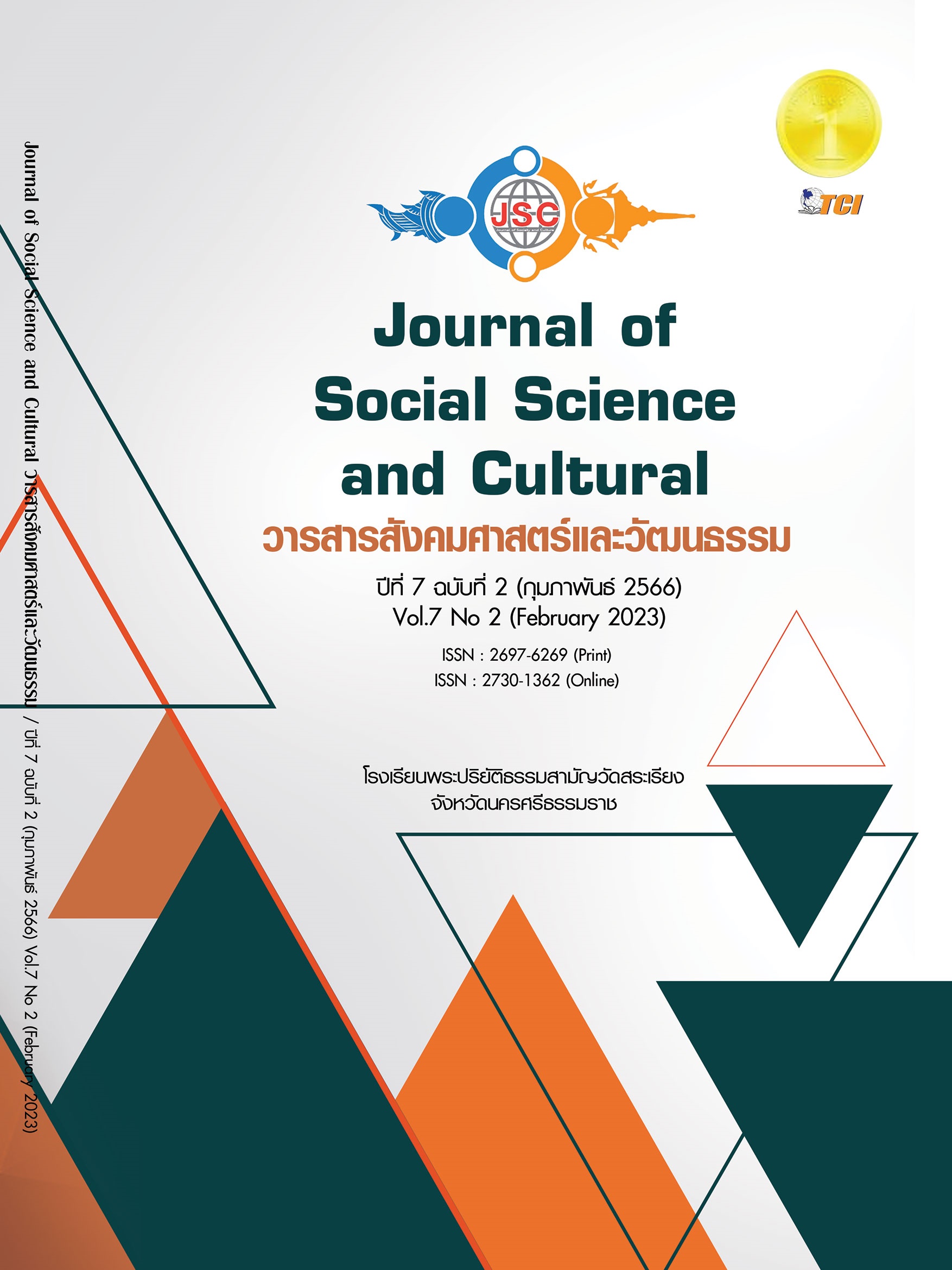THE DISCOURSE OF ROYAL PAGODA’S ESTABLISHMENT: A LITERARY ARENA OF NAKHON SI THAMMARAT’S LEGEND AND CHRONICLE
Main Article Content
Abstract
This research article aims to critical of the construction of Royal Pagoda in Nakhon Si Thammarat’s Legend and Chronicle, focusing on the meanings, knowledge sets, and contestation for meaning, using a documentary research methodology by collecting data from historical and cultural texts pertaining to the creation of Royal Pagoda, a total of 13 papers. The research methodology employed in this study includes data collection, identification of key themes, categorization, grouping, and interpretation using the conceptual framework of discourse and identity for analysis and interpretation. The results of the research indicate that the meaning of constructing Royal Pagoda has two implications. The first implication is in the context of creating centers of political power, and the second implication is in the context of creating centers of Buddhism. This study produced eight sets of knowledge, including: 1) the connection between constructing Royal Pagoda and building cities, 2) the use of names, mandates, and rituals such as Phra Chao Asoke Maharaj, 3) the enhancement of prestige through the twelve constellations cities, 4) the creation of authority over rice barns and water reservoirs according to the principle of fairness through devotions. 5) The incorporation of storytelling within Buddhist scripture and the application of local custom name to align with significant places of Buddhism. 6) The utilization of Buddhist supernatural powers and transcendental authority as the foundation for acts of kindness. 7) The pilgrimage of the people and the faith of the lay community to assist in the construction of Royal Pagoda. 8) The value of religious artifacts and as a source of resources for the city. Initially, rulers used Royal Pagoda construction as a tool for creating governmentality, but in later times, the lay community used Buddhist narrative and their own faith as tools for making Royal Pagoda the center of Buddhism.
Article Details
References
กรมศิลปากร. (2505). รวมเรื่องเมืองนครศรีธรรมราช. กรุงเทพมหานคร: กรมศิลปากร.
ฉัตรชัย ศุกระกาญจน์. (2558). 100 ปี สถาปนาพระอารามหลวง พ.ศ. 2458 - 2558 วัดพระมหาธาตุวรมหาวิหาร. นครศรีธรรมราช: อักษรการพิมพ์.
นงคราญ ศรีชาย. (2547). วัดพระมหาธาตุวรมหาวิหาร: กรณีศึกษาเกี่ยวกับการตั้งเมืองนครศรีธรรมราช. ใน กรมศิลปากร (บรรณาธิการ). ประวัติศาสตร์ โบราณคดี นครศรีธรรมราช (หน้า 187-197). กรุงเทพมหานคร: กรมศิลปากร.
นาตยา คุปกุลกานท์. (2549). วิเคราะห์ภาพสะท้อนทางสังคมและวัฒนธรรมที่ปรากฏในเอกสารและตำนานที่เกี่ยวกับพระธาตุเมืองนครศรีธรรมราช. ใน วิทยานิพนธ์ศิลปศาสตรมหาบัณฑิต สาขาวิชาไทยคดีศึกษา. มหาวิทยาลัยทักษิณ.
บัณฑิต ลิ่วชัยชาญ. (2560). ตำนานพระธาตุและตำนานเมืองนครศรีธรรมราช. กรุงเทพมหานคร: กรมศิลปากร.
ปริญญา นวลเปียน. (2558). ความรู้และอำนาจในเรื่องเล่า. ใน คธาวุฒิ เกนุ้ย (บรรณาธิการ), ตำนานและเรื่องเล่าปรัมปราท้องถิ่นภาคใต้: อัตลักษณ์ วัฒนธรรม อำนาจ และการต่อต้าน ในประวัติศาสตร์ความเป็นไทย (หน้า 4-13). กรุงเทพมหานคร: ยิปซี กรุ๊ป.
ภัคพดี อยู่คงดี. (2547). นครศรีธรรมราช ระหว่างพุทธศตวรรณที่ 19 - 23 (ร่วมสมัยสุโขทัย - อยุธยา). ใน กรมศิลปากร (บรรณาธิการ). ประวัติศาสตร์ โบราณคดี นครศรีธรรมราช (หน้า 85-104). กรุงเทพมหานคร: กรมศิลปากร.
เริงวุฒิ มิตรสุริยะ. (2552). ตำนานและพงศาวดาร ในประวัติศาสตร์แหลมทอง. กรุงเทพมหานคร: ยิปซี.
ศูนย์วัฒนธรรมภาคใต้ วิทยาลัยครูนครศรีธรรมราช และมูลนิธิโตโยต้าแห่งประเทศญี่ปุ่น. (2528ก). พระนิพพานโสตร (สำนวนที่ 1). กรุงเทพมหานคร: กรุงสยามการพิมพ์.
ศูนย์วัฒนธรรมภาคใต้ วิทยาลัยครูนครศรีธรรมราช และมูลนิธิโตโยต้าแห่งประเทศญี่ปุ่น. (2528ข). พระนิพพานโสตร (สำนวนที่ 4). กรุงเทพมหานคร: กรุงสยามการพิมพ์.


